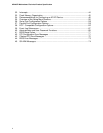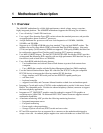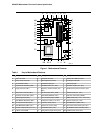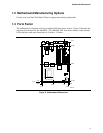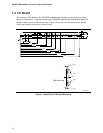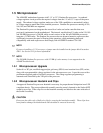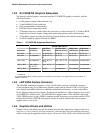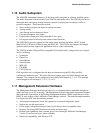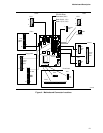AP440FX Motherboard Technical Product Specification
14
1.7.4 IDE Support
The motherboard provides two independent high performance bus-mastering PCI IDE interfaces
capable of supporting PIO Mode 3 and Mode 4 devices. The BIOS supports Logical Block
Addressing (LBA) and Extended Cylinder Sector Head (ECHS) translation modes as well as ATAPI
(e.g., CD-ROM) devices on both IDE interfaces. Detection of IDE device transfer rate and
translation mode capability is automatically determined by the BIOS.
Normally, programmed I/O operations require a substantial amount of microprocessor bandwidth.
In true multi-tasking operating systems like Windows
†
95, the microprocessor bandwidth freed up
by using PCI bus mastering IDE can be used to complete other tasks while disk transfers are
occurring. When used in conjunction with the appropriate driver for the Windows 95 environment,
the IDE interface can operate as a PCI bus master capable of supporting PIO Mode 4 devices with
transfer rates of up to 16 MB/sec.
Detailed information on the PCIset is available in the Intel 82440FX PCISet data sheet.
1.7.5 Secure Flash Support
The AP440FX motherboard uses both onboard hardware and BIOS code support to protect the
onboard flash memory device from accidentally or intentionally being corrupted. A general
purpose I/O (GPIO) port of the I/O controller is used to control the write enable line of the flash
device. By putting the microprocessor in System Management Mode (SMM) whenever the flash
write is enabled, the BIOS can ensure that the SMM code is not corrupted and that flash can only
be written from within SMM.
1.7.6 USB Support
The AP440FX motherboard has two USB ports. This permits connection of two USB peripheral
devices directly to the computer without an external hub. If more devices are required, an external
hub can be connected to either of the built-in ports. The motherboard completely supports the
standard universal host controller interface (UHCI) and takes advantage of the standard software
drivers written to be compatible with UHCI. Features of the USB include:
• Self-identifying peripherals
• Automatic mapping of function to driver and configuration
• Support for isochronous and asynchronous transfer types over the same set of wires
• Support for up to 127 physical devices
• Guaranteed bandwidth and low latencies appropriate for telephony, audio, and other
applications
• Error handling and fault recovery mechanisms built into protocol
• Low cost cables and connectors



